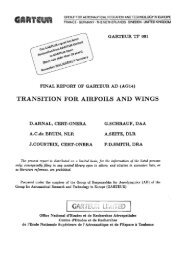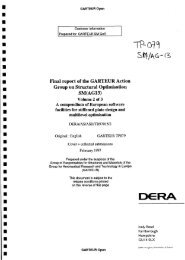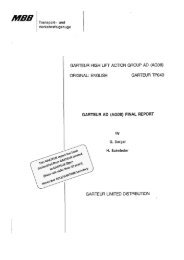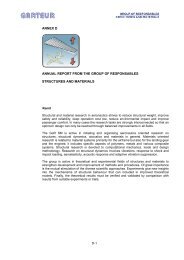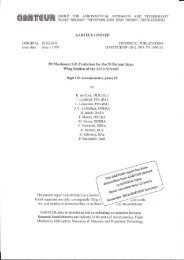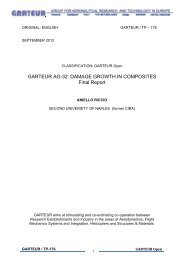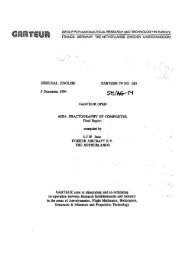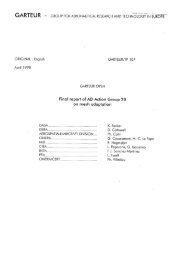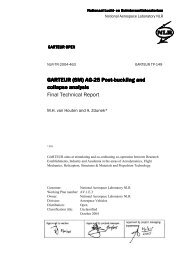Cadmium Substitution - garteur
Cadmium Substitution - garteur
Cadmium Substitution - garteur
Create successful ePaper yourself
Turn your PDF publications into a flip-book with our unique Google optimized e-Paper software.
GARTEUR LIMITED<br />
E.3 Results and discussion<br />
S-N curves were obtained for each of the coatings evaluated. Figure E2 gives examples<br />
of curves obtained for specimens electroplated with zinc-cobalt-iron and zinc-nickel. In<br />
these tests the specimens had a stress concentration factor (K t ) of 1.4.<br />
All the S-N curves obtained are given in reference E1 together with the individual fatigue<br />
specimen results.<br />
Data obtained from the S-N curves were used to calculate the relative effects of the<br />
different coatings on the fatigue strength of the steel. These are summarised in table E1.<br />
The fatigue strength for each of the coatings is compared with the fatigue strength for<br />
specimens, which have been abrasive blasted with alumina grit.<br />
The results obtained show that the coating causing the greatest reduction in fatigue<br />
strength is ED zinc - nickel. ED zinc-cobalt-iron was similar to ED cadmium giving a<br />
reduction of ~10% whilst the other coatings investigated resulted in a lowering in fatigue<br />
strength of about 5%.<br />
Several factors will influence the initiation of fatigue cracks on coated specimens. These<br />
include,<br />
• coating thickness<br />
• surface roughness due to grit blasting<br />
• peening effect due to grit blasting<br />
• strength of the base material<br />
• hydrogen embrittlement<br />
A detailed study has been made at NLR [E1] in order to identify the impact of these<br />
factors on the fatigue life. Metallographic sectioning has shown that there are<br />
considerable variations in the thickness of the coating within the notched region for each<br />
of the coatings. There were also found to be large differences in the surface roughness<br />
as a result of the pre-coating abrasive blasting treatment. This arises from the fact that<br />
the abrasive blasting was carried out by each of the organisations responsible for the<br />
different coating processes. Although surface roughness will influence the fatigue crack<br />
initiation, NLR's study suggests that the embedded aluminium oxide particles may act as<br />
preferred crack initiation sites.<br />
E.4 Conclusions<br />
1. Based on constant amplitude tests the following conclusions can be drawn<br />
concerning the effects of coatings on the fatigue strength on steel.<br />
2. By the aluminium oxide blasting treatment before the coating process the surface is<br />
roughened but also aluminium oxide particles are trapped in the surface metal.<br />
3. Entrapped oxide particles are potential fatigue crack initiation sites.<br />
4. The ED Zinc - nickel coating resulted in the largest reduction in fatigue strength,<br />
25%. This was due to the hard brittle coating and the relatively large coating<br />
thickness.<br />
5. ED zinc - cobalt - iron gave no larger reduction in fatigue strength than cadmium,<br />
~10%. The negative effect of cadmium on fatigue strength is unexplained.<br />
Page 80<br />
GARTEUR SM/AG17 TP128




